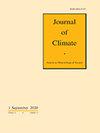全球气候变化:大气角动量和太平洋温度
IF 4.8
2区 地球科学
Q1 METEOROLOGY & ATMOSPHERIC SCIENCES
引用次数: 0
摘要
大气角动量(AAM)用于研究过去45年中地球大气环流的变化,这是一个相当大的气候变化时期。使用全球AAM,定义了两个年代际状态,涵盖1977–98年(以下简称P1)和1999–2022年(P2)。全球AAM从P1下降到P2,并伴有两半球亚热带急流减弱、北部海洋大陆周围的强对流以及热带太平洋海面温度梯度增强。周期差异反映了1)太平洋内部年代际变化(IPV),2)假定的海洋恒温器对温室气体和气溶胶排放的瞬态响应,以及3)与臭氧空洞有关的环流异常。在1977年至2023年期间,前两个过程迫使气候向更大的太平洋SST梯度和印度洋-太平洋暖池(IPWP)的极地扩张,特别是向北半球。臭氧空洞在南半球产生了自己独特的异常模式,这种模式在20世纪90年代初趋于持续。P1期间的纬向和垂直平均AAM变化在40°N和40°S之间有频繁的西风异常,并在年际时间尺度上向极地传播。在P2期间,环流主要由副热带东风异常、极移喷流和较弱的传播所主导。在当地,纬向平均异常表现为导致大陆干旱的中纬度山脊。案例研究说明了P2减弱的副热带急流,并考察了2020年初转变为拉尼娜现象背后维持P2模式的因素。本文章由计算机程序翻译,如有差异,请以英文原文为准。
Changes in the Global Climate: Atmospheric Angular Momentum and Pacific Ocean Temperatures
Atmospheric angular momentum (AAM) is used to study the variability of Earth’s atmospheric circulation during the past 45 years, a time of considerable climate change. Using global AAM, two interdecadal states are defined covering the periods 1977–98 (hereinafter P1) and 1999–2022 (P2). Global AAM decreased from P1 to P2 and was accompanied by weakened subtropical jet streams in both hemispheres, strong convection around the northern Maritime Continent, and a strengthened sea surface temperature (SST) gradient across the tropical Pacific Ocean. The period differences project onto 1) internal interdecadal Pacific variability (IPV), 2) a postulated transient ocean thermostat response to greenhouse gas and aerosol emissions, and 3) circulation anomalies related to the ozone hole. During 1977–2023, the first two processes are forcing the climate toward larger Pacific Ocean SST gradients and a poleward expansion of the Indo-Pacific warm pool (IPWP), especially into the Northern Hemisphere. The ozone hole produces its own distinct pattern of anomalies in the Southern Hemisphere that tend to become persistent in the early 1990s. The zonal and vertical mean AAM variations during P1 have frequent westerly wind anomalies between 40°N and 40°S with poleward propagation on interannual time scales. During P2, the circulation is dominated by subtropical easterly wind anomalies, poleward-shifted jets, and weaker propagation. Locally, the zonal mean anomalies manifest as midlatitude ridges that lead to continental droughts. Case studies illustrate the weakened subtropical jet streams of P2 and examine the factors behind a transition to La Niña in early 2020 that maintains the P2 pattern.
求助全文
通过发布文献求助,成功后即可免费获取论文全文。
去求助
来源期刊

Journal of Climate
地学-气象与大气科学
CiteScore
9.30
自引率
14.30%
发文量
490
审稿时长
7.5 months
期刊介绍:
The Journal of Climate (JCLI) (ISSN: 0894-8755; eISSN: 1520-0442) publishes research that advances basic understanding of the dynamics and physics of the climate system on large spatial scales, including variability of the atmosphere, oceans, land surface, and cryosphere; past, present, and projected future changes in the climate system; and climate simulation and prediction.
 求助内容:
求助内容: 应助结果提醒方式:
应助结果提醒方式:


